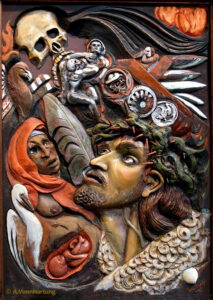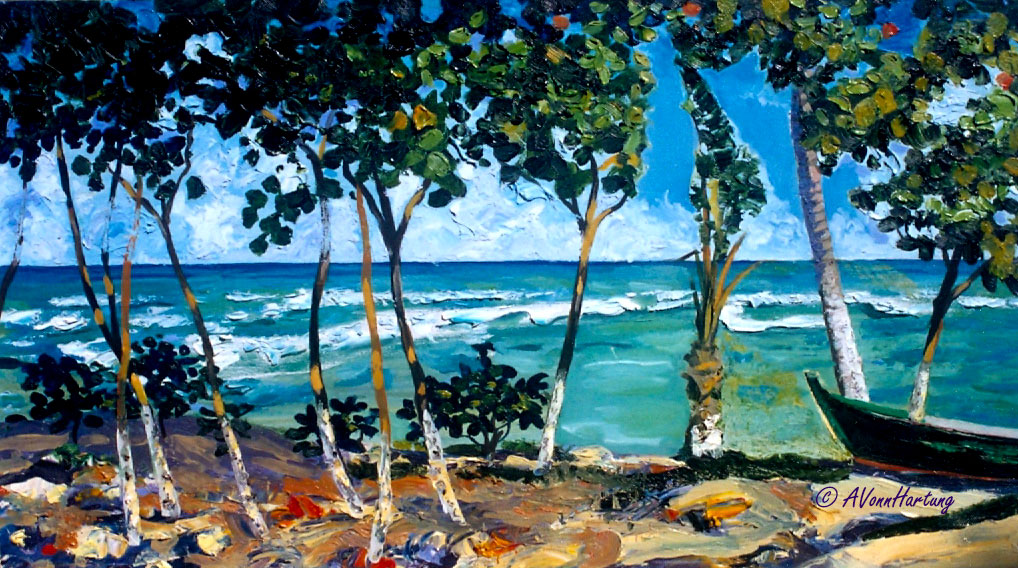
The carving THORNS OF CHRIST witnesses to the suffering of sin, injustice, and violence. Christ Lived, Healed, and taught Love through Justice for the poor and the vulnerable.
Although He was the embodiment of Love, He did express anger against sin. Indeed, He spoke without fear against evil and thus suffered death because of it.
In essence, the “Thorns of Christ” speaks of how He suffers still, seeing Injustice and violence against the innocent, the poor and the vulnerable in the world. They are persecuted and overlooked by lack of leadership, divided by deception, ignorance, and long-suffering racism.
“Thorns of Christ” was carved during 40 days of Lent in 1984, the time of the Civil war in El Salvador.
So troubled by the indiscriminate killing, rape and violence against thousands of innocent civilians caught in the conflict that, consequently, as Prayer, l carved this work.
As you might understand it was not a popular carving.
People stopped, looked, and turned away in dismay.
Art should strive to be truthful
Some feel that Art should only be beautiful.
Truth is not always beautiful and true Art should always strive to be Truthful.
During this time of Lent, I am reminded of the pain and suffering that the poor, the persecuted, the abused suffer. They are Christ in the desert. They are Christ on the cross.
I strive to live and work for a better world, a world of Justice and Compassion, of Unity and Peace.
I feel Our Lord still suffers the pain of the Nails, the pain of the Thorns that pierced His Precious body. For as long as there are innocent victims in pain, does He not still suffer?
“Lord make me an instrument of your peace.” St. Francis of Assisi
El tallado ESPINAS DE CRISTO atestigua al sufrimiento del pecado, la injusticia y la violencia. Cristo vivió, sanó y enseñó Amor a través de la justicia para los pobres y los vulnerables.
Aunque Él era la encarnación del Amor, expresó enojo contra el pecado. Habló sin miedo contra el mal, y sufrió la muerte a causa de ella.
Esta obra habla de cómo Él sufre todavía, viendo la injusticia y la violencia contra los inocentes, los pobres y los vulnerables en el mundo. Están perseguidos y pasados por alto por la falta de liderazgo, divididos por el engaño, la ignorancia y el racismo sufrido.
Tallado durante los 40 días de Cuaresma en 1984, la época de la guerra civil en El Salvador. Tan preocupado por la matanza indiscriminada, la violación y la violencia contra miles de civiles inocentes atrapados en el conflicto que, como oración, esculpí esta obra.
Como comprenderá, no se trataba de una talla popular. La gente se detuvo, miró y se volvió consternada.
El arte debe esforzarse por ser veraz
Algunos sienten que el arte sólo debe ser bello. La verdad no siempre es hermosa y el arte verdadero siempre debe esforzarse por ser veraz.
Durante este tiempo de Cuaresma, recuerdo el dolor y el sufrimiento que sufren los pobres, los perseguidos, los abusados. Son Cristo en el desiert. Son Cristo en la cruz.
Me esfuerzo para vivir y trabajar por un mundo mejor, un mundo de justicia y compasión, de la Unidad y la Paz.
Siento que Nuestro Señor todavía sufre el dolor de los Clavos, el dolor de las Espinas que traspasaron Su Precioso cuerpo. Porque mientras haya víctimas inocentes en el dolor, ¿no sufre todavía?
“Señor, hazme un instrumento de tu paz.” San Francisco de Asís
